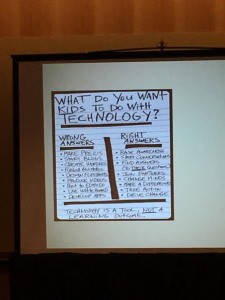This session began with a high level overview of the ways that young people of today are different than were the young people of previous generations. Specifically, how young students adapt and embrace new technologies more readily than previous generations because technology is so pervasive. The discussion swirled around the ease of access to information we now enjoy, the value of knowing things as opposed to the value of being able to find information when you need it, and how to apply information in a meaningful way.
It was a good good discussion for the first day at FETC 2016 because there was a lot of energy in the room, good ideas, and a willingness to look to the future. There was also some friction as the technology enthusiasts tossed about terms like obsolete!
Content vs. Skills
This was a significant point of the presentation; should we be teaching content, or should we be teaching students how to find the information they need, when they need it, and then how to validate that information, synthesize it, and apply it to real world situations? Is the role of the teacher to be the possessor of information, or the one who shows students how to use information and develop skills to be successful. I think that all educators believe that they are helping students develop these skills and apply their learning, though I also agree that the access to information is evolving rapidly.
Examples of the types of activities being suggested include teaching students to publish, to engage in peer review, self-reflection, and revision. For homework, rather than have students answer a series of straightforward content questions, instead ask them to explain, justify, and evaluate a position using any resource they wish.
Engagement vs. Entertainment
An interesting point of the session was a slide and discussion about technology being used for engagement vs. entertainment, and the presenter admitted to making some easy missteps in the early years of technology integration in his classroom. He would encourage students to complete an assignment by offering them time to play video games once they passed in the work. Of course, what this did was reward students for “getting it done” rather than for getting it done well. The quality of work dropped, the technology became a distraction, and it took time to overcome.
Here are some points made about the difference between Engagement and Entertainment
| Engagement | Entertainment |
| Students are active | Students are passive |
| Technology is used for learning | Technology is used for enjoyment |
| Meaningful application | Use is short-lived, minimal impact |
| Solving problems | Is an escape |
| Using creativity to express oneself | Uses the creativity of others |
This portion of the session ended with, “Entertainment should be fun and exciting, but engagement means they learn something in the end.”
How to begin?
So if a teacher is ready to begin integrating technology into their teaching in a meaningful way, how do they get started? Here are a few tips.
- Start Small. Think of one thing that you could do in the next two to three weeks.
- Collaborate. Don’t try to go it alone. Ask colleagues, share ideas.
- Take a risk. Do not let the possibility of technology not working as you expect, keep you from trying it at all.
In closing, this was a good session to begin the week. I thought this one tidbit helped to place things in perspective: “Technology is a tool, not a learning objective.”

No Responses to “Tech Non-Negotiables at FETC” Leave a reply ›